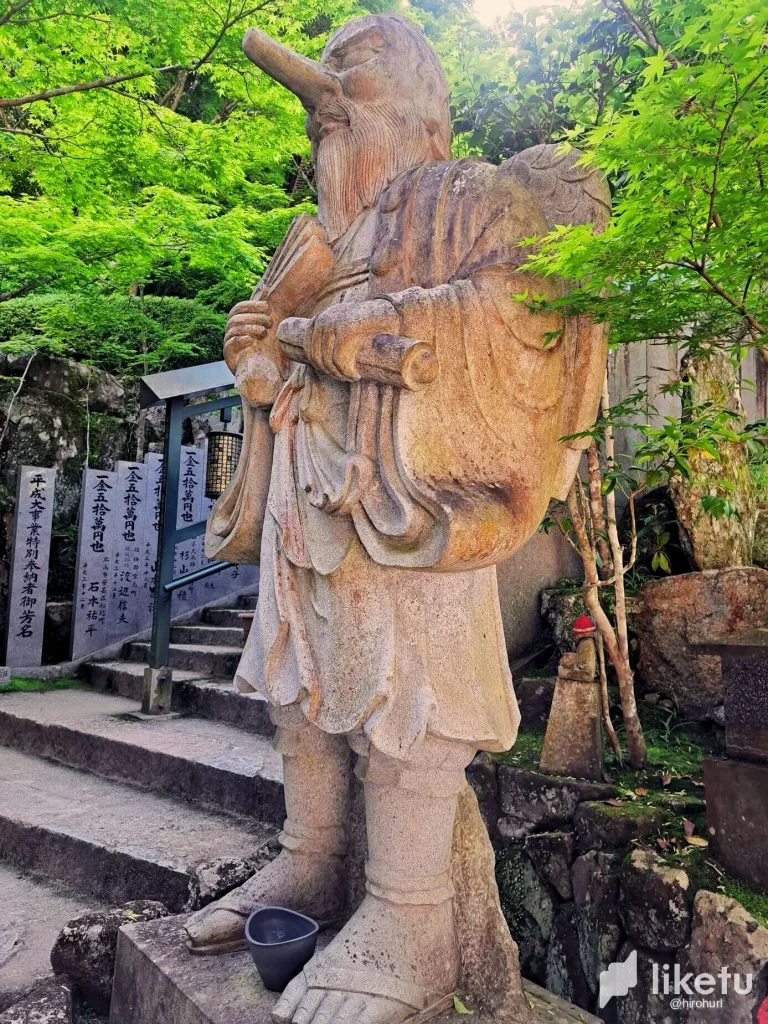
There is a statue at Daishoin Temple, Miyajima, of a "yokai" (Japanese supernatural being) in human form with crow's wings and a very long nose. He is holding a rod in one hand and a fan in the other.
This spirit creature is known as "Tengu." In more recent depictions, Tengu is a red-faced spirit with a long red nose. However, some Tengu take on crow-like qualities and usually, where there are crows wings we would expect to see a crow's head and beak, but not in this case.
The kanji (Chinese characters) for "Tengu" are "天狗"
天 = Heaven
狗 = Dog
These celestial dogs are a kind of Shinto "kami" that were taken up by various Buddhist sects including Shingon Buddhism and regarded as demons. As such, they are much more dangerous than the mishievous "tanuki" (racoon-dog) shape-shifters that I mentioned in a previous post:
Indeed, tengu were at first hostile to Buddhism and sought to decieve converts with false images of the Buddha or by shape-shifting into Buddhist priests. They would abduct monks and dump them far from their monasteries. Other monks they would seek to seduce by possessing young women. They were temple robbers. They would inspire temple donors with disreputable desires.
Later, it was said that some tengu were the ghosts of heretical or fallen Buddhist priests. As Buddhists, they could not be sent to hell, but as fallen humans, they could not be admitted into heaven, and so they, and other Buddhists who were possessed of overwheening pride, became tengu after they died.
Gradually, tengu were absorbed into the Buddhist pantheon and seen as fallen, dangerous, but not necessarily wicked, at least not all of them, and indeed some tengu became protectors of temples, but still greatly feared in the forests of Japan.
The Rod and the Fan
I mentioned that our karasu tengu statue depicts the tengu holding a rod and a fan. The rod, or "hassō" serves various symbolic and practical purposes in Tengu lore. It is said to represent the tengu's mastery over spiritual energies and their ability to control the forces of nature. In some legends, the hassō is believed to confer magical abilities upon its wielder, such as the power to command the wind or summon storms.
Additionally, the hassō is sometimes associated with the tengu's role as guardians or protectors of sacred places, such as Daishoin Temple.
The fan is known as a "tengu-ōgi" or "tengu-sensu" in Japanese. It is usually a large, feathered fan that is sometimes depicted as a weapon wielded by tengu in combat. Tengu's fan can conjure gusts of wind or deflect attacks.
The tengu sensu is also associated with tengu as mercurial messengers from the spirit realm. In some legends, tengu are said to use their fans to convey messages from the gods or even to guide travelers through the mountains and forests, suggesting that tengu can be benevolent if they feel like it.
Martial Artists and Dupes
Two other roles that tengu perform are those of martial artists and fools or dupes of crafty humans. There are stories of great Japanese generals and warriors who trained with or fought off tengu. There are also plenty of folk tales that tell of how tengu were duped, as for example, when a tengu asks a crafty chap what he is most afraid of. The fellow replies "gold" and is delighted to be showered with gold by the tengu who thought he was frightening the living daylights out of the delighted scoundrel.
Just as tengu were absorbed into the Japanese Buddhist pantheon, so have they been absorbed into the Japanese animation pantheon. You will know what I am talking about if you are a fan of "Teenage Mutant Ninja Turtles."
And that brings us right up to present times.
Cheers!
David Hurley
#InspiredFocus
For the best experience view this post on Liketu


